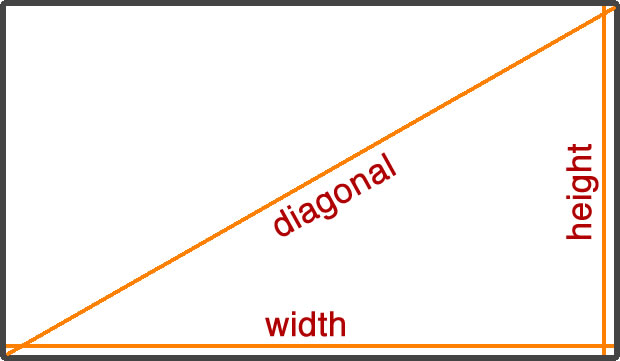Calculator Use
The PPI Calculator finds pixels per inch (PPI) and pixels per centimeter (PPcm). It will calculate PPI when inches are entered and calculate both PPI and PPcm when centimeters are entered.
PPI is a measure of pixel density or resolution of a smart phone screen, tablet screen or other display device. Pixels per inch or PPcm indicates how many pixels are in a 1 inch line or 1 cm line on a display. Also calculated are dot pitch, diagonal in pixels and total number in megapixels.
Follow These Two Steps to Calculate PPI:

1. Use the Pythagorean Theorem and the screen width and height in pixels to calculate the diagonal length in pixels:
diagonal=width2+height2‾‾‾‾‾‾‾‾‾‾‾‾‾‾‾‾√
2. Use the formula to calculate PPI, dividing the length of the diagonal in pixels by the length of the diagonal in inches
PPI=diagonal in pixelsdiagonal in inches
The number of pixels per inch or PPI tells you how many pixels are in a 1 inch line on a display screen. The PPI will be the same whether it's a horizontal or vertical or diagonal inch because pixels are square and therefore symmetric. If a display does not have square pixels then this calculator does not apply.
You can use the same PPI formula above to calculate pixels per centimeter, PPcm. Just substitute cm for inches to find PPcm.
How to Calculate PPI2 or Pixels per Square Inch
Multiply PPI × PPI to get pixels per square inch. The number of pixels in a square inch represents the resolution or pixel density of an area of one square inch. Substitute 1 cm for 1 inch to find pixels per square centimeter or PPcm2.
Example: Calculate Pixels per Inch PPI
You have a computer screen that is 1920 pixels wide by 1080 pixels high. The diagonal is 10 inches. You want to find the pixel density in one linear inch of display.
Calculate the diagonal length in pixels with the Pythagorean Theorem:
diagonalpixels = √(19202 + 10802)
diagonalpixels = √(3686400 + 1166400)
diagonalpixels = √4852800
diagonalpixels = 2202.91 pixels
Now divide:
PPI = diagonalpixels / diagonalinches
PPI = 2202.91 / 10
PPI = 220.29 pixels
So there are 220.29 pixels in a 1 inch line on the display.
Example: Calculate Pixels per Square Inch, PPI2
Using this same computer screen, PPI2 will be:
220.292 = 48528 pixels per square inch
So there are 48528 pixels in an area of the screen that is 1 inch wide by one inch high.
How to Calculate the diagonal dot pitch
Diagonal dot pitch is the diagonal distance from the center of one pixel to the center of the next. Dot pitch is calculated from the diagonal length in inches and pixels then converted from inches per pixel to millimeters per pixel but normally only expressed in millimeters (mm).
dot pitch=diagonal in inchesdiagonal in pixels×25.4mminch
If a screen diagonal is 15.4 inches and has 3396 pixels. Dot pitch = (15.4/3396) × 25.4 ≈ 0.1152 mm.